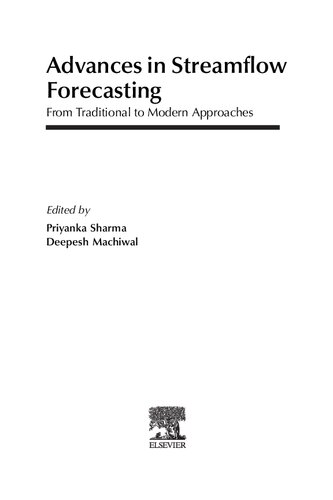

Most ebook files are in PDF format, so you can easily read them using various software such as Foxit Reader or directly on the Google Chrome browser.
Some ebook files are released by publishers in other formats such as .awz, .mobi, .epub, .fb2, etc. You may need to install specific software to read these formats on mobile/PC, such as Calibre.
Please read the tutorial at this link: https://ebookbell.com/faq
We offer FREE conversion to the popular formats you request; however, this may take some time. Therefore, right after payment, please email us, and we will try to provide the service as quickly as possible.
For some exceptional file formats or broken links (if any), please refrain from opening any disputes. Instead, email us first, and we will try to assist within a maximum of 6 hours.
EbookBell Team

5.0
28 reviewsAdvances in Streamflow Forecasting: From Traditional to Modern Approaches covers the three major data-driven approaches of streamflow forecasting including traditional approach of statistical and stochastic time-series modelling with their recent developments, stand-alone data-driven approach such as artificial intelligence techniques, and modern hybridized approach where data-driven models are combined with preprocessing methods to improve the forecast accuracy of streamflows and to reduce the forecast uncertainties.
This book starts by providing the background information, overview, and advances made in streamflow forecasting. The overview portrays the progress made in the field of streamflow forecasting over the decades. Thereafter, chapters describe theoretical methodology of the different data-driven tools and techniques used for streamflow forecasting along with case studies from different parts of the world. Each chapter provides a flowchart explaining step-by-step methodology followed in applying the data-driven approach in streamflow forecasting.
This book addresses challenges in forecasting streamflows by abridging the gaps between theory and practice through amalgamation of theoretical descriptions of the data-driven techniques and systematic demonstration of procedures used in applying the techniques. Language of this book is kept simple to make the readers understand easily about different techniques and make them capable enough to straightforward replicate the approach in other areas of their interest.
This book will be vital for hydrologists when optimizing the water resources system, and to mitigate the impact of destructive natural disasters such as floods and droughts by implementing long-term planning (structural and nonstructural measures), and short-term emergency warning. Moreover, this book will guide the readers in choosing an appropriate technique for streamflow forecasting depending upon the given set of conditions.